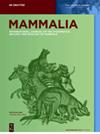Distribution of the northern pampas cat, Leopardus garleppi, in northern South America, confirmation of its presence in Colombia and genetic analysis of a controversial record from the country
IF 0.8
4区 生物学
Q3 ZOOLOGY
引用次数: 0
Abstract
Abstract The common name of pampas cat includes a complex of small Neotropical felid species found in various habitats of South America. Recently several species of this complex were proposed, but there are few records in the northernmost distribution of the continent, and reports of the pampas cat’s presence in Colombia have been ambiguous. Current northern limits of Leopardus garleppi are limited to the Andes of Ecuador. Here we present the northernmost record of the species, validating its presence in Colombia and review previous controversial records from the country. The new record is based on a road-killed specimen in a dry tropical forest ecosystem in the municipality of Mercaderes, Department of Cauca. Our morphological and genetic comparisons also shown that a previous record from Colombia supported by a single skin recently used to described a new species named Leopardus narinensis belong to Leopardus tigrinus. With the information compiled from new localities in Colombia and Ecuador, the known distribution range for L. garleppi is increased towards the northern part of South America into areas of Tropical Dry Forest. The distribution now includes 14 ecoregions from Colombia to Bolivia, and four in Colombia (Eastern Cordillera real montane forests, Northwestern Andean montane forests, Northern Andean paramo, and the Patía Valley dry forests), which correspond to similar ecosystems inhabited by the species in other Andean landscapes. The potential distribution hypothesis showed that the species has high suitability in large areas of southwestern Colombia (Nariño). With the recording of L. garleppi in Colombia, the number of extant felid species in the country has increased to seven.南美北部潘帕斯草原北部猫科动物Leopardus garleppi的分布,确认其在哥伦比亚的存在,并对该国有争议的记录进行遗传分析
潘帕斯猫(pampas cat)的共同名称包括在南美洲各种栖息地发现的小型新热带猫科动物的复合体。最近提出了这一复杂物种的几个物种,但在非洲大陆最北端的分布很少有记录,关于潘帕斯猫在哥伦比亚存在的报道也很模糊。目前,加勒皮Leopardus garleppi的北部范围仅限于厄瓜多尔的安第斯山脉。在这里,我们展示了该物种最北端的记录,证实了它在哥伦比亚的存在,并回顾了该国以前有争议的记录。新的记录是基于在考卡省梅尔卡德尔斯市一个干燥的热带森林生态系统中被道路杀死的标本。我们的形态学和遗传学比较还表明,哥伦比亚的一个单皮记录最近被用来描述一个名为narinensis的新物种,属于tigrinus。根据从哥伦比亚和厄瓜多尔的新地区收集的信息,已知的garleppi分布范围向南美洲北部的热带干林地区扩大。分布现在包括从哥伦比亚到玻利维亚的14个生态区,以及哥伦比亚的4个生态区(东科迪勒拉真正的山地森林,西北安第斯山地森林,北安第斯帕拉莫和Patía山谷干林),这些生态系统与其他安第斯景观中物种居住的类似生态系统相对应。潜在分布假设表明,该物种在哥伦比亚西南部的大片地区具有很高的适宜性(Nariño)。随着在哥伦比亚记录到L. garleppi,该国现存的猫科动物种类增加到7种。
本文章由计算机程序翻译,如有差异,请以英文原文为准。
求助全文
约1分钟内获得全文
求助全文
来源期刊

Mammalia
生物-动物学
CiteScore
2.20
自引率
10.00%
发文量
68
审稿时长
6-12 weeks
期刊介绍:
Mammalia is an international, multidisciplinary, bimonthly journal devoted to the inventory, analysis and interpretation of mammalian diversity. It publishes original results on all aspects of the systematics and biology of mammals with a strong focus on ecology, including biodiversity analyses, distribution habitats, diet, predator-prey relationships, competition, community analyses and conservation of mammals. The journal also accepts submissions on sub-fossil or recently extinct mammals.
 求助内容:
求助内容: 应助结果提醒方式:
应助结果提醒方式:


